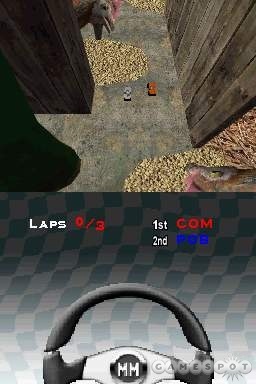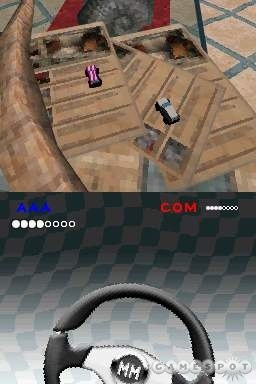Micro Machines aren't nearly as popular now as they once were, but the miniature collectible cars are still racing in Micro Machines V4, yet another top-down racing game from Codemasters. It's been 15 years since the original Micro Machines game appeared on the Nintendo Entertainment System, and the formula hasn't changed a bit in all that time. Rather than focusing on bringing the series up to date, or even just polishing up the presentation, V4 simply adds more of the same--a lot more, in fact. This game has more weapons, more tracks, and more cars than you could possibly know what to do with. The Nintendo DS version also adds some worthless touch-screen controls and shrinks everything even further to fit the small DS screen. But for all that content, the novelty of racing tiny cars just isn't as entertaining as it used to be, which leaves Micro Machines V4 sitting on four flat tires.

The most notable feature of V4 is its impressive array of collectible miniatures. There are a whopping 750 cars to collect in the game, and you can even trade them with your friends over a local wireless connection. The vehicles are divided into 25 classes, such as concept, muscle, off-road, and even gas guzzlers. You collect these cars by completing more than 75 single-player challenges in the game. The collection aspect of the game makes sense given the Micro Machines license, and it provides you with plenty of incentive to keep playing the game. You can race any of the cars that you've collected, or you can just go into the garage and look at them. The problem is that the cars are generic and lack some much-needed detail, especially on the smaller screen of the handheld. The vehicles look blocky and are painted in dull, flat colors, and there isn't much variety because although there are a ton of vehicles in the game, many are just different-colored versions of the same model. They don't sound unique, either, with a constant and annoyingly high-pitched whine being the universal engine noise in the game.
Despite their standardized appearance, the vehicles do handle somewhat differently. Each vehicle has ratings for speed, acceleration, grip, and handling, which all affect how the car moves on the course. The difference between a car with a high speed rating and one with a low speed rating is noticeable, although with so many vehicles you'll invariably end up racing a lot of vehicles that are pretty average in their performance. As a result, you'll feel as though you're driving the same car most of the game until you get behind the wheel of some of the nonstandard vehicles, like trucks or dragsters. The Nintendo DS version of the game offers a control option that lets you use the touch screen to steer your vehicle. You can accelerate using the up direction on the D pad or the A button while manipulating a small steering wheel that appears on the lower screen of the DS. This control method works so poorly that it's almost impossible to use, making it nothing more than a throwaway gimmick.
Regardless of which type of car you drive, the racing technique is always the same. You hold the gas button down constantly, powerslide around every corner, and try not to fall off the edge of the track. As in previous Micro Machines games, the tracks you race on are all set in average, everyday places, like a kitchen countertop, a garden, or a workbench. The game does a decent job of providing a sense of scale, duplicating the Honey, I Shrunk the Kids effect of having ordinary items that you see every day appear massive and daunting. You'll see giant hairbrushes, chickens that seem to be 10 stories tall, rain gutters wide enough to fit three cars comfortably, and so on. Some of the tracks are creative and fun, while others cover the same themes that you've seen in every Micro Machines game ever made. Unfortunately, the sense of scale is diminished on the small screen of the DS. The lack of detail also makes the tracks look bland and lifeless. Some of the background details that give the tracks character in the console versions of V4 are either missing or are difficult to make out in the DS version. The DS game also suffers from occasional--though no less annoying--slowdown, which kills any sense of speed the game may have had up to that point.
Most of the tracks are quite perilous given the slippery handling of the cars, a problem that is compounded by the fact that it can be extremely difficult to even see where you're going, due to a constantly shifting top-down perspective. In the game's battle mode, you have to get enough of a lead over your opponent to cause him to leave the screen. In these events the camera zooms out to keep all of the vehicles in the picture, so if you're in the lead you have no view of the track ahead and have to rely entirely on memory to determine when to turn.
On the DS, the point at which the trailing car is knocked out is inconsistent and difficult to judge. Sometimes you'll seem to hang on for quite a while at the bottom edge of the screen; at other times, you'll barely fall behind the lead car and be instantly disqualified. This adds another level of frustration to the already difficult task of racing without being able to see where you're going. As soon as one racer drops out the camera finally zooms back in, which is helpful because it usually improves your view of the course; but at the same time, the frequent movement of the camera can be disorienting because you never get the chance to get used to one perspective. Even when the camera stays put, as it does in the standard race mode, it can still be difficult to navigate the courses unless you've driven them several times before and have memorized each turn. If you miss a turn you'll go flying off the edge of the track, and some of the tracks are very narrow and feature plenty of deviously sharp turns. The way that most of the single-player challenges are structured, even one slight mistake is enough to make you fail; so there is very little room for error.
There are several basic race types in Micro Machines V4. The most common race is the battle race, where you earn points by driving so far ahead of your opponents that they leave the screen. There are also standard three-lap races, time trials, and checkpoint races. In the checkpoint races, you have to reach the next checkpoint on the track before your time runs out. Passing through a checkpoint earns you more time, but just barely enough to let you reach the next checkpoint--as long as you don't make any mistakes. The checkpoint races are slightly more forgiving in the DS version than in other versions, but they can still be incredibly difficult. It's aggravating to run a perfect race right up to the end only to slip off an edge or take a turn too wide and have to repeat the entire race.
While the focus of V4 is on driving fast and staying on the course, there's also a combat element to the game. When you're racing or battling, you'll collect items scattered throughout the course that can be used to attack your enemies or heal yourself. There are a variety of weapons, including machine guns, missiles, bombs, and even giant hammers. When you attack an opponent, his car will take damage. As the car becomes damaged it drives slower and doesn't handle as well, and if a car takes enough damage it will lose wheels and eventually stop altogether. The weapons add a bit more chaos and excitement to the game, but more often than not it's easier to simply bump an opponent off the track or outrun him than it is to blow him up.

You can play the game with up to three other players over a local wireless network, but each player has to have a copy of the game, which limits your chances of ever actually experiencing the multiplayer component of Micro Machines V4. If you do happen to find other people who own the game you can play battle mode or run a standard three-lap race, and you can choose to turn the power-ups on or off as you see fit. You can also trade cars that you've collected, but it's difficult to get excited about trading a blue box-shaped car for a red box-shaped car.
The sheer number of cars and tracks in Micro Machines V4 is impressive, but the actual racing just doesn’t hold up. Some of the tracks are cleverly designed and are genuinely interesting, but even then, the frustrating camera and loose handling of the vehicles can make for a trying race. These problems are worsened by the blurry graphics and small screen. The Nintendo DS library isn't exactly rife with excellent racing games, and unfortunately, Micro Machines V4 doesn't do anything to change that.



